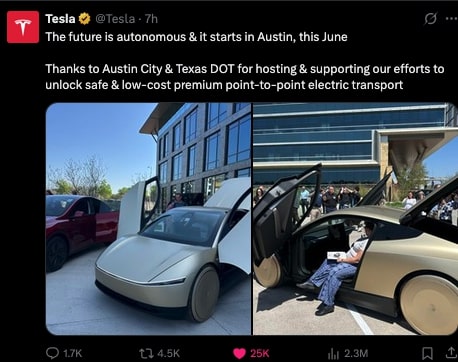Now Reading: LLM Scale and Solving of Programming as a Path to Superintelligence
-
01
LLM Scale and Solving of Programming as a Path to Superintelligence
LLM Scale and Solving of Programming as a Path to Superintelligence

Yann LeCun’s argues that there are limitations of chain-of-thought (CoT) prompting and large language model (LLM) reasoning. LeCun argues that these fundamental limitations will require an entirely new structure and foundation for AI to achieve true reasoning and true innovation.
Integrating language models and planning systems, creating more versatile and capable technologies that address the hierarchical planning deficits.
Multi-modal systems with millions of years of video data will be highly capable and will have or will integrate with world models.
In June 2025, Tesla robotaxi breakthrough should see hundreds of thousands of cars without human drivers giving paid rides in Austin and then spreading around the world to millions of cars in 2026.
It took 6 billion miles of driving data to reach this point. A mile per minute of video. It is one minute to drive a mile at 60 miles per hour. Two minutes at 30 miles per hour. 6 billion miles of driving data is about 11000 years of driving data. Tesla AI and FSD is 1000-10000 times less efficient than humans learning to drive. Although learning to drive perfectly (like the robotaxi goal of over 10 times safer than human) probably takes a human 5-10 years. We can use millions of cameras to gather data for 2-3 years. This will mean millions of years of video for AI to train. The compute is increasing at about 100 times each year and will affordably scale to a million or a billion times current compute levels (100-1000X more GPUs, 100-1000X better GPUs, 100X-1000X more algorithmic efficiency).
All the audio, video and text data and statistically generated synthetic data will create awesome world models and capabilities. This is already showing positive economic returns by displacing google search. This is sufficient to solve robotaxi and humanoid bots. Those are multi-trillion markets. They will also solve computer programming.
Can there be even better AI systems from new paradigms ? Yes. Until those new paradigms prove themselves they will have to work with growing LLM capabilities.
-Advanced LLMs will be profitable without new paradigms
-Advanced LLMs and hybrid AI will solve robotaxi, humanoid bots, video, world models that match the physical world
-hallucinations will either be completely solved or mitigated for commercial use cases
-Programming enhancement via AI can be a path to hallucination free AI generated systems and superintelligent and supercapable systems.
1. Speed-Based Superintelligence (Much Faster Human-Level Intelligence)
This type describes an AI that operates at human-level intelligence but processes information and makes decisions at a speed far beyond what humans can achieve. Think of it as a human mind turbocharged to work in nanoseconds instead of seconds or minutes. Near future LLMs with a million or billion times more data combined with speed and integrated with regular programs that they help generate would be a very capable form of superintelligence.
Key Features:
Extremely fast at analyzing data, recognizing patterns, and performing calculations.
Matches human cognitive ability but doesn’t exceed it in depth or creativity.
Interpolation and great innovations and leaps in understanding would be limited without broader understanding and really deep reasoning.
2. Understanding-Based Superintelligence (True Superintelligence and very deep reasoning that LeCun is referring)
This is what you’ve called “true superintelligence”—an AI that doesn’t just work faster but also surpasses humans in the depth of its understanding, creativity, and adaptability. It’s not just about speed; it’s about thinking in ways humans can’t.
Key Features:
Solves complex, abstract problems across multiple domains.
Capable of learning, innovating, and even improving itself without human input.
Might possess qualities like consciousness, self-awareness, or the ability to set its own goals.
Sustainable Revenue Will Mean Sustainable Modification of the Current Research Paths
Yann LeCun admits that large LLMs could get all data on particular subjects and answer any questions on those subjects. We already see the LLMs can add significant reasoning analysis using the large data. These systems are going beyond Google search already. They are proving to have significant value and revenues.

Researchers are exploring and implementing hybrid approaches where LLMs contribute their strengths—vast knowledge and language understanding—while planning algorithms handle structured reasoning.
For instance:
An LLM could generate a high-level plan (e.g., “To cook dinner, gather ingredients, preheat the oven, and assemble the dish”).
A planning system could then refine this into actionable steps (e.g., “Turn the oven to 350°F at 5:00 PM”).
Projects like Tesla’s FSD and AlphaZero prove that integrating hierarchical planning with advanced AI is not only feasible but already successful. While these systems don’t yet use LLMs directly, they pave the way for future architectures where LLMs could play a key role, blending language mastery with structured decision-making.
Yann LeCun’s See Major Flaws and Limits of CoT and LLM Reasoning
Yann LeCun, a leading AI researcher and Meta’s chief AI scientist, argues that LLMs have significant limitations in reasoning and planning, even with techniques like chain-of-thought prompting.
His main points are:
Lack of True Reasoning: LeCun asserts that LLMs rely on pattern matching and memorization from their training data rather than genuine reasoning or abstraction. He views CoT as a superficial method that guides output generation rather than reflecting internal reasoning processes.
Autoregressive Limitation: LLMs predict the next word based on previous words, unlike human cognition, which involves planning and reasoning before generating language. This autoregressive nature leads to errors like “hallucinations” (plausible but incorrect outputs).
No Physical World Understanding: Trained primarily on text, LLMs lack sensory grounding and cannot truly understand the physical world, a capability LeCun considers essential for reasoning.
Not a Path to AGI: LeCun believes LLMs cannot lead to artificial general intelligence (AGI) due to their missing capabilities like hierarchical planning and persistent memory.
Nextbigfuture believes that LeCun is overstating his case and that valuable forms of AGI and superintelligence will be achieved within the current paradigm. There is still the need for other new paradigms and innovation.
Data Supporting LeCun Limits of LLM Case
Studies show LLMs struggle with tasks requiring deep reasoning or physical concepts absent from their training data.
LLMs frequently produce hallucinations, highlighting their reliance on statistical patterns over comprehension.
Performance drops on tasks needing long reasoning chains or complex planning, as errors compound with each step.
Counterarguments to LeCun’s
Some AI researchers and experts challenge LeCun’s views, arguing that LLMs can exhibit reasoning-like behavior and that their limitations can be mitigated. Their key points include:
Emergent Reasoning with Scale: Larger LLMs, combined with techniques like CoT prompting, show improved multi-step reasoning, suggesting that scaling and prompting can unlock reasoning abilities.
Generalization Evidence: LLMs can solve novel problems or answer questions not explicitly in their training data, indicating some level of reasoning and generalization.
Multi-Modal Progress: New multi-modal LLMs, integrating text with sensory inputs like vision or audio, address the lack of physical understanding.
Practical Achievements: Successes in tasks like translation and problem-solving suggest LLMs possess a form of reasoning, even if not fully human-like.
Data Supporting Counterarguments:
CoT prompting experiments demonstrate better performance on reasoning tasks, implying step-by-step guidance works.
LLMs solve some out-of-training-data problems, supporting claims of generalization.
Multi-modal models improve on tasks like visual question answering, showing progress in physical understanding.
New Paradigms for AI
To overcome LLM limitations and advance toward human-like intelligence, several promising paradigms are emerging:
Objective-Driven AI: LeCun advocates for AI that builds world models from sensory inputs, enabling physical understanding and interaction, unlike text-only LLMs.
Hierarchical Planning: New architectures aim to mimic human cognition by planning at multiple abstraction levels, improving decision-making and complex task handling.
Embodied AI and Robotics: Integrating AI with physical bodies allows learning through environmental interaction, providing sensory grounding absent in LLMs.
Unsupervised and Self-Supervised Learning: These approaches enable AI to learn from vast unlabeled datasets, reducing reliance on human-labeled data and fostering broader generalization.
Yann LeCun argues that LLMs, even with CoT, lack true reasoning, physical understanding, and planning due to their reliance on pattern matching, supported by evidence of their struggles with deep reasoning and hallucinations. Critics counter that scaling, CoT, and multi-modal approaches enable reasoning-like behavior, backed by improved task performance and generalization examples. Promising new paradigms like objective-driven AI, hierarchical planning, embodied AI, and unsupervised learning aim to address these limitations and push AI toward more human-like capabilities. The debate remains active, with both sides offering compelling insights into AI’s future.

Brian Wang is a Futurist Thought Leader and a popular Science blogger with 1 million readers per month. His blog Nextbigfuture.com is ranked #1 Science News Blog. It covers many disruptive technology and trends including Space, Robotics, Artificial Intelligence, Medicine, Anti-aging Biotechnology, and Nanotechnology.
Known for identifying cutting edge technologies, he is currently a Co-Founder of a startup and fundraiser for high potential early-stage companies. He is the Head of Research for Allocations for deep technology investments and an Angel Investor at Space Angels.
A frequent speaker at corporations, he has been a TEDx speaker, a Singularity University speaker and guest at numerous interviews for radio and podcasts. He is open to public speaking and advising engagements.























